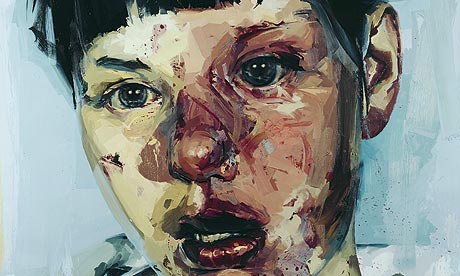A record album is being covered up in UK supermarkets. The author of this Guardian article is at pains to point out that the painting could be interpreted in many ways; perish the thought of the painter intending to convey anything specific by it.

The impact the Manic Street Preachers album cover has made raises the interesting possibility that hand-made, painterly images now have more power to shock than conceptual artworks.
It’s hard to imagine the chain of decisions that led to Jenny Saville’s painting of a boy’s face in colours that vary from olive green to reddish brown, blue and black, being judged too offensive to go on public view. The painting can apparently be interpreted to show blood on the boy’s face – although as the band rightly point out, this is a subjective view. He might have crimson scars and battered lips; or these might just be the colours Saville has used to evoke the appearance of flesh. The whites and creams, the blues of his eyes, are just as shocking.
The author of the article goes on to explain what it means to him; one would expect no less than an interpretation that includes psychic hurt. After all, most modern art induces psychic hurt.
For me this is a painting of psychic hurt, a portrait of pain. In that sense it is truly troubling – but to see it crudely as an image of a child who has been hit (which must be the supermarkets’ view) is to impose your own subjective interpretation. Paint creates uncertainty. It is genuinely impossible to know if those red marks are bloody scars or expressive smears. In the end, what has caused offence is the intrusion of emotion and artistic depth into the temples of commercial banality.
We are left with the predictable jibe at what has supposedly caused offence. The problem is, the writer of this article blames the supermarkets for having a subjective opinion which has been “imposed” on the art, while at the same time having his own subjective opinion, also, one assumes, “imposed” on the art.
If art is to be valued entirely subjectively, an art critic can scarcely complain if people find it subjectively offensive and respond by covering it up.




